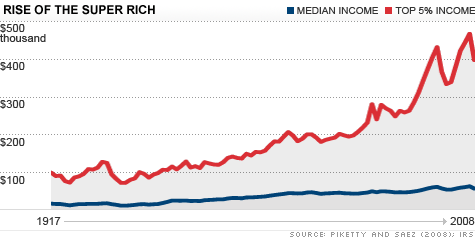How the middle class became the underclass

The average American's income has not changed much, while the richest 5% of Americans have seen their earnings surge. This chart includes capital gains.
By Annalyn Censky, staff
NEW YORK (CNNMoney) -- Are you better off than your parents?
Probably not if you're in the middle class.
Incomes for 90% of Americans have been stuck in neutral, and it's not just because of the Great Recession. Middle-class incomes have been stagnant for at least a generation, while the wealthiest tier has surged ahead at lighting speed.
In 1988, the income of an average American taxpayer was $33,400, adjusted for inflation. Fast forward 20 years, and not much had changed: The average income was still just $33,000 in 2008, according to IRS data.
Meanwhile, the richest 1% of Americans -- those making $380,000 or more -- have seen their incomes grow 33% over the last 20 years, leaving average Americans in the dust.
Experts point to some of the usual suspects -- like technology and globalization -- to explain the widening gap between the haves and have-nots.
But there's more to the story.
A real drag on the middle class
One major pull on the working man was the decline of unions and other labor protections, said Bill Rodgers, a former chief economist for the Labor Department, now a professor at Rutgers University.
Because of deals struck through collective bargaining, union workers have traditionally earned 15% to 20% more than their non-union counterparts, Rodgers said.
But union membership has declined rapidly over the past 30 years. In 1983, union workers made up about 20% of the workforce. In 2010, they represented less than 12%.
"The erosion of collective bargaining is a key factor to explain why low-wage workers and middle income workers have seen their wages not stay up with inflation," Rodgers said.
Without collective bargaining pushing up wages, especially for blue-collar work -- average incomes have stagnated.
International competition is another factor. While globalization has lifted millions out of poverty in developing nations, it hasn't exactly been a win for middle class workers in the U.S.
Factory workers have seen many of their jobs shipped to other countries where labor is cheaper, putting more downward pressure on American wages.
"As we became more connected to China, that poses the question of whether our wages are being set in Beijing," Rodgers said.
Finding it harder to compete with cheaper manufacturing costs abroad, the U.S. has emerged as primarily a services-producing economy. That trend has created a cultural shift in the job skills American employers are looking for.
Whereas 50 years earlier, there were plenty of blue collar opportunities for workers who had only high school diploma, now employers seek "soft skills" that are typically honed in college, Rodgers said.
A boon for the rich
While average folks were losing ground in the economy, the wealthiest were capitalizing on some of those same factors, and driving an even bigger wedge between themselves and the rest of America.
For example, though globalization has been a drag on labor, it's been a major win for corporations who've used new global channels to reduce costs and boost profits. In addition, new markets around the world have created even greater demand for their products.
"With a global economy, people who have extraordinary skills... whether they be in financial services, technology, entertainment or media, have a bigger place to play and be rewarded from," said Alan Johnson, a Wall Street compensation consultant.
As a result, the disparity between the wages for college educated workers versus high school grads has widened significantly since the 1980s.
In 1980, workers with a high school diploma earned about 71% of what college-educated workers made. In 2010, that number fell to 55%.
Another driver of the rich: The stock market.
The S&P 500 has gained more than 1,300% since 1970. While that's helped the American economy grow, the benefits have been disproportionately reaped by the wealthy.
And public policy of the past few decades has only encouraged the trend.
The 1980s was a period of anti-regulation, presided over by President Reagan, who loosened rules governing banks and thrifts.
A major game changer came during the Clinton era, when barriers between commercial and investment banks, enacted during the post-Depression era, were removed.
In 2000, President Bush also weakened the government's oversight of complex securities, allowing financial innovations to take off, creating unprecedented amounts of wealth both for the overall economy, and for those directly involved in the financial sector.
Tax cuts enacted during the Bush administration and extended under Obama were also a major windfall for the nation's richest.
And as then-Federal Reserve chairman Alan Greenspan brought interest rates down to new lows during the decade, the housing market experienced explosive growth.
"We were all drinking the Kool-aid, Greenspan was tending bar, Bernanke and the academic establishment were supplying the liquor," Deutsche Bank managing director Ajay Kapur wrote in a research report in 2009.
But the story didn't end well. Eventually, it all came crashing down, resulting in the worst economic slump since the Great Depression.
With the unemployment rate still excessively high and the real estate market showing few signs of rebounding, the American middle class is still reeling from the effects of the Great Recession.
Meanwhile, as corporate profits come roaring back and the stock market charges ahead, the wealthiest people continue to eclipse their middle-class counterparts.
"I think it's a terrible dilemma, because what we're obviously heading toward is some kind of class warfare," Johnson said.



